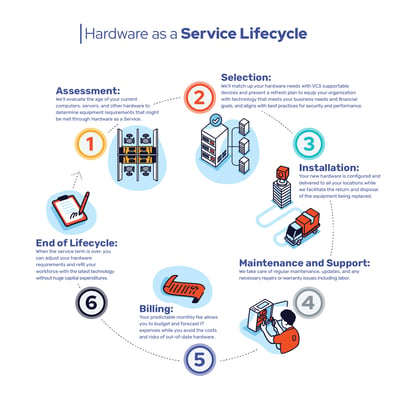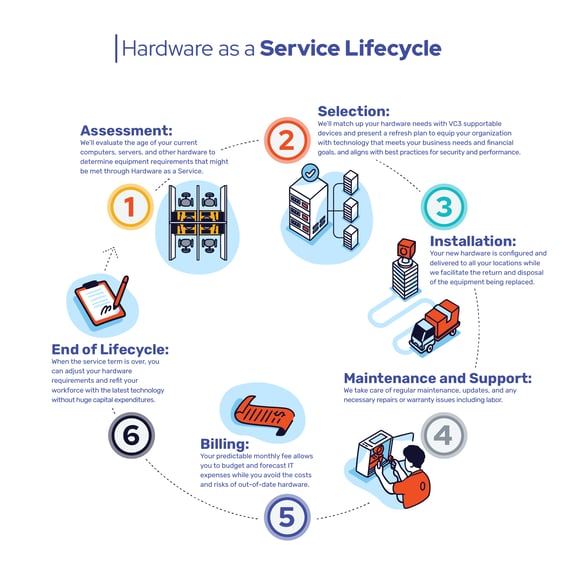What if you could eliminate the capital expense of purchasing computers, servers, and other hardware that your organization needs and instead get the equipment for a predictable monthly fee? This is possible with Hardware as a Service (HaaS).
Hardware as a Service has evolved into a new model for equipping organizations with computer equipment in a way that’s similar to how cloud services are purchased. With the cloud, you “subscribe” to what you need, from infrastructure and file storage to software and communication tools. HaaS involves the same kind of arrangement.
With HaaS, you never actually own what you use so you don’t have big capital expenditures or surprise costs when something breaks. Your people won’t struggle with the unpredictability that comes with aging hardware and you can optimize security with the most up-to-date features.
In this article, you’ll learn about:
- HaaS Makes Hardware Updates Simple
- Security and Compliance with HaaS
- How Does HaaS Work?
- HaaS Options and Limitations
- Is Hardware a a Service Right for Your Organization?
HaaS Makes Hardware Updates Simple
When you utilize HaaS, you pay a monthly fee for a certain period of time for the use of servers, computers, network infrastructure, and peripheral equipment—depending on your agreement. When the term ends, you exchange the old equipment for new.
HaaS is great for organizations that want to:
- Ensure hardware is in peak performance and compatible with modern software.
- Replace capital expenses with a predictable monthly fee.
- Have flexibility to scale without long-term hardware investments.
- Avoid the security risks inherent in older hardware.
- Avoid the drag and downtime that comes with aging hardware.
Security and Compliance with HaaS
Older hardware poses major security risks because it lacks the latest features and updates, creating vulnerabilities that can easily be exploited. Additionally, failure to update hardware can result in non-compliance with industry regulations for data privacy, which could lead to penalties and legal consequences, as well as increased exposure to cyber threats.
With HaaS, the provider keeps the hardware patched, updated, and supported with the latest security tools and best practices. You don’t have to worry about hardware becoming unsupported by the vendor or needing to maintain security updates by yourself.
How Does HaaS Work?
While there are a few variables that come into play when you’re crafting a HaaS plan for your organization, the overall process is straightforward.

- Assessment: The provider evaluates the age of your current computers, servers, and other hardware to determine equipment requirements that might be met through Hardware as a Service.
- Selection: Your hardware needs are matched up with the provider’s list of supportable devices. They’ll draft a plan to equip your organization with technology that meets your business needs and financial goals while aligning with best practices for security and performance.
- Installation: New hardware is configured and delivered or shipped to your locations while the provider facilitates the subsequent return and disposal of the equipment being replaced.
- Maintenance and Support: The provider takes care of regular maintenance, updates, and any necessary repairs or warranty issues (including labor).
- Billing: Payment is made through a predictable monthly fee which allows you to budget and forecast IT expenses while avoiding the costs and risks of out-of-date hardware.
- End of Life: When the service term is over, you can adjust your hardware requirements and refit your workforce with the latest technology without huge capital expenditures.
HaaS Options and Limitations
Every managed service provider (MSP) has its own parameters for how they offer HaaS. You can expect some choices and some limits.
📖 Related Resource: Pros and Cons of HaaS
1. Types of Devices
The provider will have a set of industry-standard servers, laptops, monitors, docking stations, etc. along with network infrastructure such as firewalls, switches, and UPS devices. However, that doesn’t mean they can't be flexible. It's important that the devices in your subscription match up to your needs, instead of being restricted to a generic equipment list.
2. Software Integration
The MSP should be able to configure devices with operating systems and software that match up with the specific applications you’re already using. Most applications are standard or easily compatible with the hardware, but integration may involve cases requiring customization or help from the software vendor.
3. Contract Duration
The minimum HaaS contract duration is typically three years, with a maximum of five. Monthly recurring payments are calculated based on the number of months in the agreement. If you sign a long-term HaaS agreement, cancellation may not be possible or it may incur fees.
4. Scalability
A key advantage of HaaS is scalability. Whether it's accommodating a sudden surge in users or scaling down during lean times, HaaS provides the flexibility to adjust hardware resources to match evolving needs.
5. End-of-Term Options
When your HaaS term is complete, you may have the option to update to newer hardware models, upgrade to a different device or configuration, or simply return the equipment. Under some agreements, you will not be able to buy and keep the equipment.
Is HaaS Right for Your Organization?
Moving to a HaaS model is a big decision, but if hardware upgrades and new purchases strain your finances, limit scalability, and impact employee productivity, and if the predictable cost structure provided by a hardware subscription would relieve this stress, then HaaS is definitely something you should try.
HaaS Solutions for VC3 Clients
At VC3, we offer HaaS solutions for many types of computer equipment--from firewalls, switches, and UPS devices to laptops, monitors, and docking stations. Clients that have already taken advantage of this service have experienced tangible benefits from adopting a proactive approach to hardware sourcing. They have gained the flexibility, scalability, and cost-effectiveness that a subscription-based model provides while ensuring their IT infrastructure remains up to date and responsive to evolving needs.
HaaS is just one service that organizations can utilize when they partner with VC3 for managed IT services. Get in touch to explore everything VC3 can do to help you navigate your technology journey.


